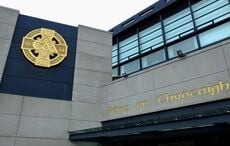An abandoned Irish cemetery lies tucked within the hills of western Albemarle County, Virginia. Only a few miles east of the historic Blue Ridge Tunnel, it’s located on a gentle rise next to Pollak Vineyards. I call it the Quinn Cemetery.
A low stone wall exactly 75 feet square defines the space. It’s quite likely that the weathered hands of an Irish stone mason erected the wall sometime between 1850 and 1860. During these years, many hundreds of single Irish men and scores of Irish families moved to the area.
Refugees from the Great Hunger raging in Ireland, they settled in for a decade of backbreaking toil. With volatile black gunpowder and hand chisels, they blasted through the almost one-mile-long Blue Ridge Tunnel at Rockfish Gap, Virginia. They also built three shorter tunnels and laid thirty-four miles of connecting tracks.
About twenty-five Irish are buried in the Quinn Cemetery. Casualties of the railroad construction, their remains lie beneath roughly rectangular, unmarked field stones. One single, inscribed headstone stands in the center of the graveyard. It leans slightly, as if losing the strength to continue its lonely job. Beneath a simple carved cross is this inscription:
In memory of
EUGENE
Died August 4 1855
Aged 1 year 7 months
Also
MARY
Died August 4 1856
Children of John & Hannah Quinn
I know from payroll records that John Quinn was an Irish stone mason who worked on the Blue Ridge Tunnel. But I may never know how little Eugene and Mary died; death records for Albemarle County from that time are incomplete.
I do know that cholera, pneumonia, whooping cough, and unknown causes struck down other children of the Blue Ridge Railroad. However the Quinn children died, it’s enough to know that John Quinn and his Irish wife, Hannah Kelley Cotter Quinn, felt a keening grief when they placed these two small bodies in the ground.
More than two years ago, I helped found Clann Mhór, a research group focused on the Blue Ridge Railroad. Last month, I started a new group called Clann Mhór Rising (http://clannmhorrising.blogspot.com). We take a more scholarly approach to the study of the railroad and the laborers who built it. Our first mission was helping informants who share last names with John Quinn and Hannah Kelley Cotter Quinn to register the cemetery with the Virginia Department of Historic Resources.
Our second mission has been arranging a visit to the Quinn Cemetery on Saint Patrick’s Day. In a brief ceremony, a few Quinn, Kelley, and Cotter folks would commemorate the deaths of the Quinn children with readings, prayers, and bowed heads. A piper or flute player would accompany us if possible. Organizing the group will be easy. The problem is access.
___________________
READ MORE:
Ghost of 19th century nun appears in one of series of photos - PHOTOS
New facts about Great Famine emigration out of Ireland revealed
In honor of the Simpson’s 500th episode - our favorite Irish moments from the show
__________________
No public road leads to the remote Quinn Cemetery, but it’s reachable by foot from the adjacent Pollak Vineyards. A former vineyard employee allowed members of Clann Mhór to visit four times in 2010. Archaeologist Stephen Brighton from the University of Maryland was present on one of the trips, as well as a 2011 visit when recent damage to the cemetery wall from a bulldozer was clearly visible.
And that brings me to this upcoming Saint Patrick’s Day. Clann Mhór Rising has sent a certified letter to Michael and Cynthia Erkel, current owners of the cemetery land (I refuse to say they own the cemetery or the Irish bones resting there). We also sent a letter to David and Margo Pollak, owners of the vineyard. The appeal was simple enough: Please let our Quinn-Kelley-Cotter group honor the Quinn children and the other Irish dead on March 17th.
The Erkels and Pollaks have ignored our request. Readers of Irish Central who want to help can telephone, send snail mail, or write emails to the land owners. Respectfully urge them to let us honor our Irish dead.
Business contact information for the Erkels is publicly available at www.erkel.com. Business contact information for the Pollaks is publicly available at http://pollakvineyards.com/contact.php.
©2011, 2012 Mary E. Lyons. All rights reserved.
Mary E. Lyons is an Affiliate Fellow of the Virginia Center for the Humanities
www.lyonsdenbooks.com




Comments